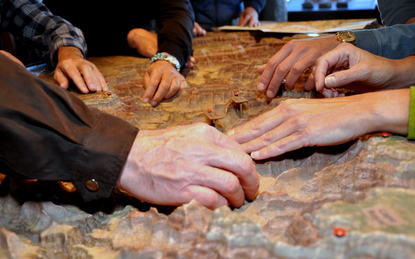|

NPS Photo by Michael Quinn
Contact: Shannan Marcak, 928-638-7958 Grand Canyon, Ariz. -- Grand Canyon National Park staff recently hosted a focus group on accessibility and universal design in wayside exhibits. Wayside exhibits (often called waysides) are the traditional, outdoor, hip-height and upright signage found adjacent to roadways and trails on public lands across the country. They are used to foster direct and meaningful connections between visitors and the landscape, to alert visitors to safety and resource management issues, and to provide information. Grand Canyon National Park's Division of Interpretation and Resource Education is in the midst of a major wayside rehabilitation and replacement project. "This project has provided the park with an opportunity to work toward more universally accessible wayside exhibits in the highly visited Grand Canyon Village," said Exhibit Specialist Jennie Albrinck, a member of the wayside rehabilitation team. "We want to improve the ways in which our waysides communicate with all visitors, including those who are blind or visually impaired." According to Albrinck, the traditional, flat, one-dimensional wayside panel is not universally accessible and is especially challenging to people with visual impairments. "Looking at ways to communicate using tactile and audio elements would create more universal access, allowing park information and interpretive messages to reach more audiences." The purpose of the focus group was to provide first hand insight into challenges presented by the current waysides and to explore means of improving wayside accessibility. To ensure the group's success, park staff sought the assistance of the National Center on Accessibility (NCA). The NCA worked with park staff to develop a schedule of activities and topics, organize a focus group of blind and visually impaired individuals from a variety of disciplines and experiences, and facilitate group discussions. Included in those discussions were members of the park's exhibit planning, cultural resources, compliance, and diversity coordination staffs; representatives from Harpers Ferry Center (the National Park Service's center for exhibit design); and representatives from the project's wayside design contractor, Kirilloff Design, and fabricator, Aardvark Graphic Solutions, Inc.. In addition, two contract historians, Mike Anderson and Amanda Zeaman, were included because the Village waysides will all be located within a National Historic Landmark District, and several of the exhibits explore the architecture and history of the area. During their three days in the park, group members made site visits to most of the existing waysides in the Village and to the Yavapai Geology Museum, which offered some examples of tactile exhibits. Their experiences and observations at these sites served as the foundation for group discussions. Topics discussed included the seven principals of universal design, expenses involved in universal design, design products and environments that allow for universal access (as well as those that do not), how to best communicate in a tactile presentation, and how to best communicate in an audio presentation. While the results of the focus group discussions are still being collated and summarized, Kirilloff Design and Aardvark Graphic Solutions are already planning to incorporate some of the ideas discussed into a prototype wayside panel – an orientation to the Village area. Once approved, three versions of this prototype, fabricated of different materials, will be placed in Grand Canyon Village for nine months to evaluate how well each meets the needs of all audiences, as well as how sustainable the exhibits are with the park's high visitation and variable climate. In addition, the ideas and recommendations that the group developed will be synthesized into a summary report and shared with other interested parks, as well as the National Park Service's Intermountain Region and Washington offices. Park staff are also exploring the possibility of training sessions, presented in partnership with NCA, that would allow parks currently or soon to be working toward universal accessibility in their waysides to benefit from the lessons learned at Grand Canyon. According to Albrinck, working with the focus group served as a great reminder that while visitors with visual impairments require more assistance with orientation and wayfinding than is typically offered or available, they do not expect more than the average visitor – they simply want access to the full range of opportunities to learn, engage, and experience the park in a meaningful way. For additional information on the wayside project or the accessibility focus group, please contact Jennie Albrinck, Exhibit Specialist, at 928-638-7639 or Carl Bowman, Exhibit Planner, at 925-638-7773. To obtain a copy of the park's Accessibility Guide, please go to https://www.nps.gov/grca/parknews/upload/AccessibilityGuide06.pdf; and to learn more about visiting Grand Canyon National Park, go to www.nps.gov/grca. -NPS- |
Last updated: February 24, 2015
